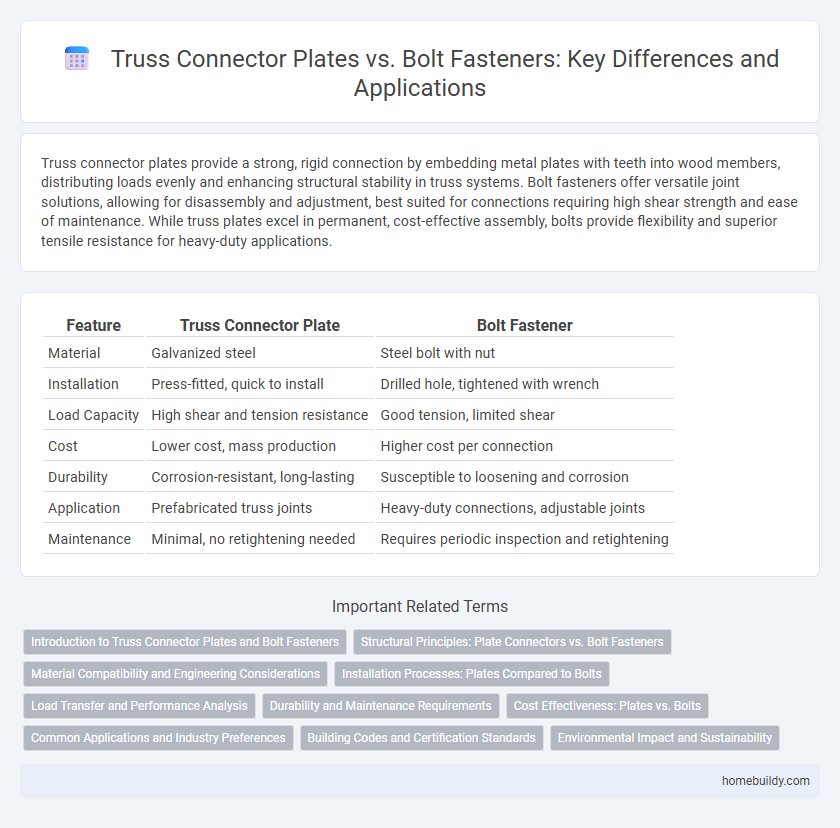Truss connector plates provide a strong, rigid connection by embedding metal plates with teeth into wood members, distributing loads evenly and enhancing structural stability in truss systems. Bolt fasteners offer versatile joint solutions, allowing for disassembly and adjustment, best suited for connections requiring high shear strength and ease of maintenance. While truss plates excel in permanent, cost-effective assembly, bolts provide flexibility and superior tensile resistance for heavy-duty applications.
Table of Comparison
| Feature | Truss Connector Plate | Bolt Fastener |
|---|---|---|
| Material | Galvanized steel | Steel bolt with nut |
| Installation | Press-fitted, quick to install | Drilled hole, tightened with wrench |
| Load Capacity | High shear and tension resistance | Good tension, limited shear |
| Cost | Lower cost, mass production | Higher cost per connection |
| Durability | Corrosion-resistant, long-lasting | Susceptible to loosening and corrosion |
| Application | Prefabricated truss joints | Heavy-duty connections, adjustable joints |
| Maintenance | Minimal, no retightening needed | Requires periodic inspection and retightening |
Introduction to Truss Connector Plates and Bolt Fasteners
Truss connector plates are engineered metal connectors designed to join wooden truss components securely, providing consistent load distribution and enhanced structural integrity. Bolt fasteners offer adjustable and removable connections, enabling flexibility in assembly but may require precise torque settings to ensure safety and stability. Both methods play crucial roles in construction, with connector plates favored for permanent, high-strength joints and bolt fasteners preferred for applications needing disassembly or realignment.
Structural Principles: Plate Connectors vs. Bolt Fasteners
Truss connector plates distribute loads across a wide surface area, enhancing shear transfer and reducing localized stress concentrations compared to bolt fasteners. Bolt fasteners rely on tensile strength and bearing capacity at discrete points, which can create stress risers and potential slip within connections. Plate connectors offer improved stiffness and load sharing in truss joints, while bolts provide adjustability and ease of disassembly.
Material Compatibility and Engineering Considerations
Truss connector plates are typically made from galvanized steel or stainless steel, ensuring excellent compatibility with wood materials by preventing corrosion and providing uniform load distribution. Bolt fasteners, often composed of high-strength alloy steel, require precise engineering calculations to manage shear and tension forces without compromising the wood's structural integrity. Engineering considerations highlight that connector plates facilitate quicker installation and consistent performance, while bolts offer adjustable connections but demand careful material matching to avoid issues such as moisture-induced corrosion or wood splitting.
Installation Processes: Plates Compared to Bolts
Truss connector plates simplify installation with their pre-punched teeth that embed directly into the wood using a hydraulic press, reducing labor time and ensuring uniform load distribution. In contrast, bolt fasteners require precise alignment of drilled holes and manual tightening, which can prolong the installation process and introduce variability in joint strength. The efficient press-fit process of connector plates minimizes installation errors and enhances structural integrity compared to bolts.
Load Transfer and Performance Analysis
Truss connector plates provide superior load transfer by distributing forces evenly across multiple fastener points, minimizing stress concentrations compared to bolt fasteners. Bolt fasteners typically concentrate loads at discrete points, increasing the risk of material fatigue and potential failure under cyclic loading conditions. Performance analysis shows that truss connector plates enhance structural integrity and durability in wood truss applications by optimizing shear and tension force distribution.
Durability and Maintenance Requirements
Truss connector plates offer superior durability due to their corrosion-resistant materials and ability to distribute loads evenly, reducing the risk of structural failure compared to bolt fasteners. Bolt fasteners require regular inspection and tightening to maintain integrity, as they are more susceptible to loosening and environmental damage. Maintenance requirements for truss connector plates are significantly lower, making them a more reliable and long-lasting option in structural applications.
Cost Effectiveness: Plates vs. Bolts
Truss connector plates offer a cost-effective solution compared to bolt fasteners due to lower material and labor expenses, enabling faster installation and reduced labor hours. Bolt fasteners often require more time for precise alignment and tightening, increasing overall project costs. The efficient manufacturing and mass production of connector plates further reduce costs, making them a preferred choice in large-scale truss construction projects.
Common Applications and Industry Preferences
Truss connector plates are widely used in residential and commercial wood framing for their ease of installation and ability to distribute loads evenly across joints, making them ideal for roof trusses and floor systems. Bolt fasteners are preferred in heavy timber construction and steel framing due to their high strength and removability, commonly seen in bridges and industrial buildings. Industry standards favor connector plates for mass-produced trusses while bolts dominate applications requiring disassembly or adjustment.
Building Codes and Certification Standards
Truss connector plates must comply with building codes such as the International Building Code (IBC) and standards by the American Institute of Steel Construction (AISC), ensuring structural reliability and fire resistance. Bolt fasteners are regulated under standards like the American Society for Testing and Materials (ASTM) A325 and A490, which specify mechanical properties and load capacities for structural applications. Compliance with certifications from agencies like ICC-ES guarantees that both truss connector plates and bolt fasteners meet performance requirements critical for safe building construction.
Environmental Impact and Sustainability
Truss connector plates generally have a lower environmental impact compared to bolt fasteners due to their efficient use of steel, reducing material waste during manufacturing. These plates enable quicker assembly, decreasing on-site energy consumption and emissions associated with prolonged construction. Furthermore, steel truss connector plates are often recyclable, supporting sustainability through circular material use in structural applications.
truss connector plate vs bolt fastener Infographic

 homebuildy.com
homebuildy.com